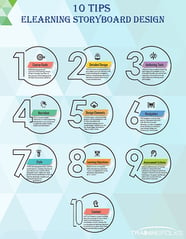How to Create Custom eLearning That Delivers Results
Since eLearning is highly customizable and can cover a variety of niches, it's important to have an idea of what you need so that you can create a custom eLearning course that fits your company's goals. With this in mind, let's go over the core principles of creating a custom eLearning course that works when engaging eLearning development companies.

Define Performance and Learning Objectives for the Course
A well built eLearning course is designed by an Instructional Technologist, aligning to the goals, performance, and learning objectives. For example, early in the course the learner should discover what they're learning, how they will learn it, and why the training will be useful to them in their job.
Performance objectives and learning objectives are two types of goals that are used to define what learners should be able to do as a result of the eLearning courses. While both types of objectives are related to learning, they are different in some ways.
Performance objectives are specific, observable, and measurable goals that describe the actions that students should be able to perform after taking the eLearning courses. They focus on what students will be able to do, rather than on the knowledge or skills they will retain. For example, a performance objective might be: After completing the eLearning course, the student will be able to problem solve a software issue within 15 minutes.
Learning objectives, on the other hand, focus on the knowledge or skills that students will acquire as a result of the eLearning courses. They are typically more general and less specific than performance objectives, and they may not be directly observable or measurable. For example, a learning objective might be: "After completing the eLearning course, the student will understand the key concepts and techniques for using a specific software."
In summary, performance objectives are specific and measurable goals that describe the actions that learners should be able to take as a result of training, while learning objectives are more general goals that describe the knowledge or skills that learners will acquire. Both types of objectives are important in the instructional design process, but they serve different purposes and should be used appropriately.
The Subject Matter Expert
Subject matter experts (SMEs) play an important role in the instructional design process by providing the necessary knowledge and expertise on the topic being developed. They are responsible for reviewing and approving the content of the eLearning course to ensure that it is accurate and up-to-date.
In the instructional design process, SMEs typically work closely with the instructional technologist to confirm the learning objectives for the eLearning course and its objectives. They may also provide input on the most effective teaching methods and resources for the training.
Overall, the subject matter expert plays an important role in the design process by providing the necessary knowledge to ensure that the eLearning program is accurate and effective.
Build an Intuitive Learning Structure
When aiming for specific learning outcomes, it is important to design your eLearning course that is divided into modules that cover simple concepts. This modular approach will allow you to create a course that presents the material to be learned in a logical progression system. For example, employees on a construction site would be taught on-site safety procedures before being exposed to more advanced concepts such as specific waste disposal techniques.
Consider All Learning Styles
There are several different adult learning styles that can impact how adults approach learning and education. These styles can be categorized into three main types: visual, auditory, and kinesthetic.
Visual learners tend to learn best through the use of visual aids such as diagrams, charts, and graphs. They may also prefer to take detailed notes or create mind maps to help them process and understand new information.
Auditory learners prefer to learn through listening and speaking. They may benefit from lectures, discussions, and verbal explanations of concepts. They may also prefer to participate in group discussions and debates to help solidify their understanding of a topic.
Kinesthetic learners prefer to learn through hands-on experiences and activities. They may benefit from hands-on demonstrations, experiments, and practical application of concepts. They may also prefer to take breaks and move around while learning in order to stay engaged.
It is important to note that many adults may have a combination of learning styles and may prefer different methods of learning depending on the subject matter. It is also important for instructional technologists to be aware of the different learning styles of their students and to incorporate a variety of teaching methods in order to meet the needs of all learners.
Active Learning
Active learning is a teaching approach that involves engaging students in the learning process through activities, discussions, and other forms of interactive instruction. In eLearning, active learning can be achieved through a variety of methods, including:
Interactive modules: ELearning courses can incorporate interactive modules that allow students to practice applying their learning through activities such as simulations, games, and quizzes.
Discussions: forums and chat rooms can provide students space to engage in discussions and share their ideas with one another.
Team/cohort work: Collaborative tools such as OneDrive and MS Teams can be used to allow students to work on group projects and share their work with one another.
Problem-based learning: eLearning courses should present students with business problems to solve, which can help to make the learning relevant and applicable to their lives.
Overall, incorporating active learning into eLearning can help to make the learning experience more dynamic and engaging. Using a variety of interactive activities and collaborative tools, an instructional technologist can create eLearning programs that promote active learning and helps students to retain and apply their learning.
Be Mindful of the Length
Keeping an eLearning course as short as possible without omitting critical information is important for both the learning process and productivity. This means that you'll need to put a lot of thought into what information makes it into your custom training course and what you'll need to leave out. Remember, the sooner your employees complete their training and can get to work, the more productive they will be.
Language is Important
When creating a custom eLearning course that works, it is important to present it in a language that connects with your target audience. In this case "language" means much more than verbal languages such as English, Spanish, etc. Instead, it's more about using terminology that your target audience will understand. This can mean using the right acronyms, slang, and technical jargon associated with the course material. As a result, your employees will learn better, and your eLearning course will come across as being authentic and created by a true subject matter authority.
Ready to get started with eLearning and not sure where to begin?
Get our FREE DOWNLOAD: "10 Tips: eLearning Storyboard Design"


